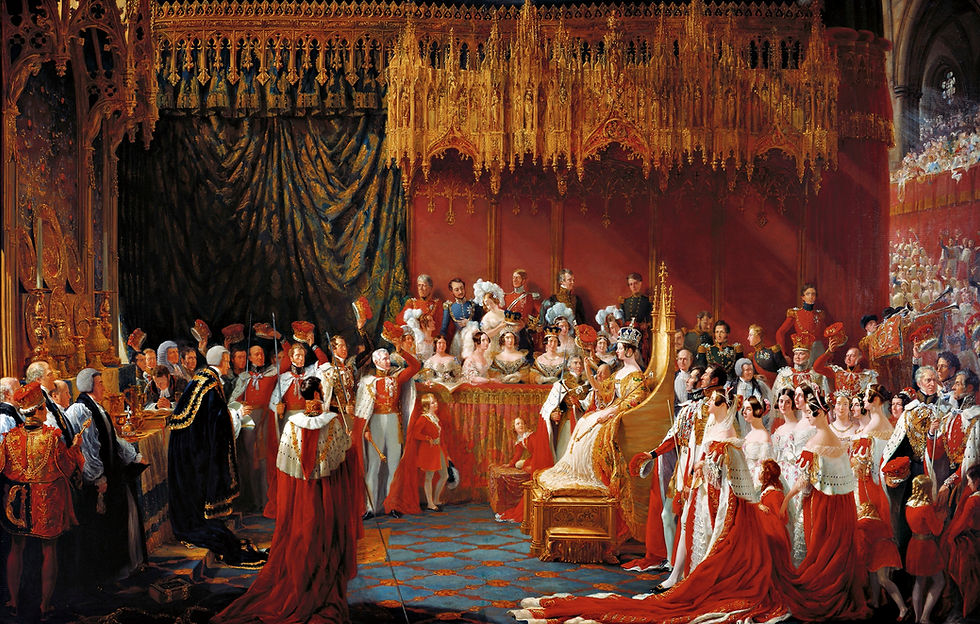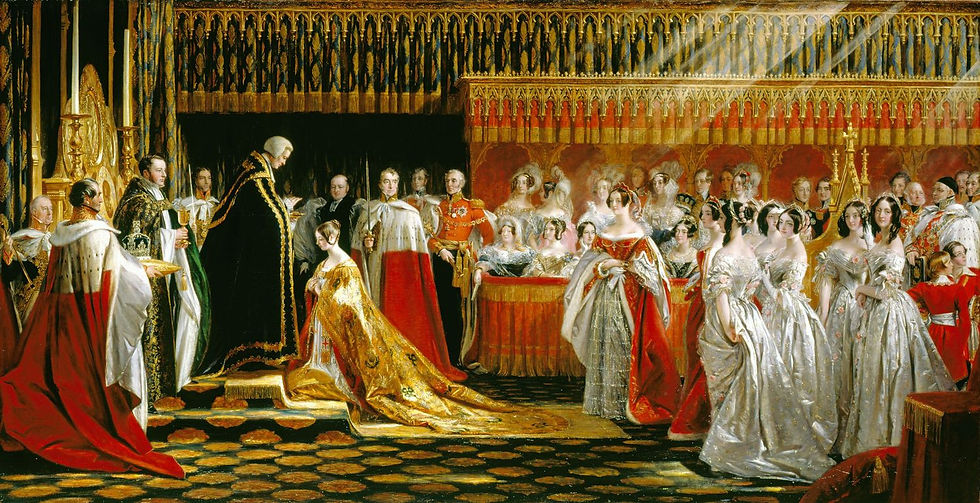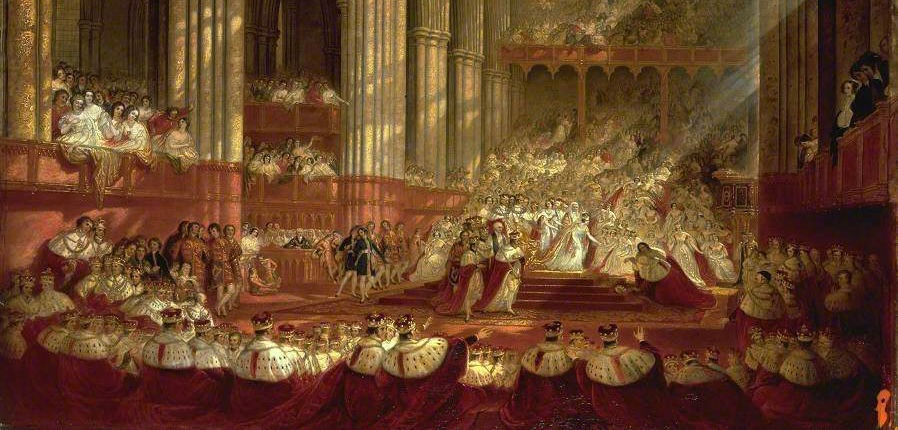With an extreme lack of rehearsal, a falling Lord and a picnic at the alter, Queen Victoria's £79,000 Coronation certainly didn't go as smoothly as you might expect. Join me, Amelia Stephenson, as I explore Queen Victoria's Coronation hiccups.

At 4am on 28th June 1838, Queen Victoria woke up, feeling "strong and well", to the sound of guns firing in the park, bands playing and crowds gathering at Constitution Hill. Six hours later, at 10am, the nineteen-year-old Queen climbed into the infamously uncomfortable Gold State Coach with the Duchess of Sutherland and Lord Albermale, before heading along the hour and a half long route to Westminster Abbey, which was lined by over 400,000 bystanders. Later that day, The Queen wrote in her journal how "their good humour & excessive loyalty was everything.
I cannot say how proud I felt to be Queen of such a nation."
The evening before the ceremony took place, the Queen attended a quick rehearsal at the Abbey and left "rather glad" that she had attended, "as I shall now know exactly where I'm to go, and be". However, this wasn't the case and the Queen still relied heavily on others to guide her - the only problem was that they too were clueless on what was meant to happen!

Upon arriving at the Abbey, just after 11:30, the Queen went into the Robing Room, where she was greeted by her eight train bearers: Lady Caroline Lennox, Lady Adelaide Paget, Lady Mary Talbot, Lady Fanny Cowper, Lady Wilhelmina Stanhope, Lady Anne Fitzwilliam, Lady Mary Grimston and Lady Louisa Jenkinson, who were all wearing white satin dresses, decorated with pink roses. After putting on her Mantle, the Queen began her procession down the aisle. However, this is where the lack of rehearsal began to show.
As Lady Wilhelmina Stanhope later described, the trains on the train bearers dresses "were serious annoyances" as they constantly found themselves treading on them; something that she believed could have been prevented had proper rehearsals taken place! As a result, the eight young ladies "carried the Queen's train very jerkily and badly, never keeping step properly". In her notes, Wilhelmina reflects on how "it must have been very difficult for her [the Queen] to walk, as she did, evenly and steadily, and with grace and dignity, the whole length of the Abbey".
The lack of foot coordination probably hadn't been helped by the slightly unusual music, which was directed by Sir George Smart, who foolishly made the decision to to act as both the conductor and the organ player. It's needless to say he didn't do much conducting and the whole musical production was a shambles!

On top of all this, when she finally reached St Edward's Chapel, the Queen was shocked to find "plates of sandwiches, [and] bottles of wine" on the altar, which - according to Queen Victoria's journal - "Ld Melbourne said, was more unlike a Chapel, than anything he had ever seen". However, while it might seem unusual to have sandwiches in such a sacred place, they were in fact a lifeline to anyone attending the five hour long service. Like the coronation of King Charles IlI in May 2023, Victoria then went into a back room of the chapel to change outfit.
Upon removing her "crimson Robe & Kirtle", she "put on the Super Tunica of cloth of gold, also in the shape of a Kirtle" she also removed her Circlet of diamonds before taking her place on St. Edwards's Chair, where another, much more painful, blunder was to take place.
Following tradition, a new ring had been made for the investiture. Traditionally the ring is a symbol of 'kingly dignity' and is placed on the ring finger. However, the royal goldsmiths, Rundell, Bridge & Rundell, had misinterpreted the 'fourth finger' as being the little finger rather than the ring finger.
Despite the ring clearly being too small, the Archbishop of Canterbury insisted on forcing it onto the correct finger, causing the Queen excruciating pain. In her journal, Victoria described how she later "had the greatest difficulty in taking it off again," but thankfully with the help of ice, she succeeded in doing so - "but not without great pain."

Now, you'd expect that paying homage to your new Queen would be quite an easy process, but this unfortunately wasn't the case for elderly Lord Rolle, who took a tumble when trying to ascend the steps. According to Harriet Martineau, "the large infirm old man was held up by two Peers, and had nearly reached the royal footstool when he slipped through the hands of his supporters, and rolled over and over down the steps, lying at the bottom coiled up in his robes". Another attendee, Charles Greville, wrote that the Queens "first impulse was to rise [to his aid, and when he came again to do homage she said "May I not get up and meet him?" and rose from the throne and advanced down one or two of the steps to prevent him coming up, an act of graciousness and kindness which made a great sensation".

While we might wish the mishaps ended there, there are two final errors that show just how disorganised this historic event had been. The first being that the Bishop of Durham gave Victoria the Ceremonial Orb at the wrong time, so, when the Archbishop went to give it to her, he was shocked to find that she "had already got it, & he (as usual) was most confused & puzzled & knew nothing, - & went away." Victoria remained there a few moments before preparing to leave the Abbey.
However, the Bishop of Bath and Wells had accidentally flipped two pages of the program at once and prematurely declared the service complete. By the time his mistake had been noticed, Victoria had already withdrawn to St. Edward's Chapel so had to be called back in to complete the service.
Despite almost everything going wrong and the clear "want of rehearsal," Queen Victoria wrote in her journal that she "shall ever remember this day as the proudest in my life".
© QueenVictoriaRevival 2024
This article is the intellectual property of Queen Victoria Revival and should not be COPIED, EDITED, OR POSTED IN ANY FORM ON ANOTHER WEBSITE under any circumstances unless permission is given by the author.